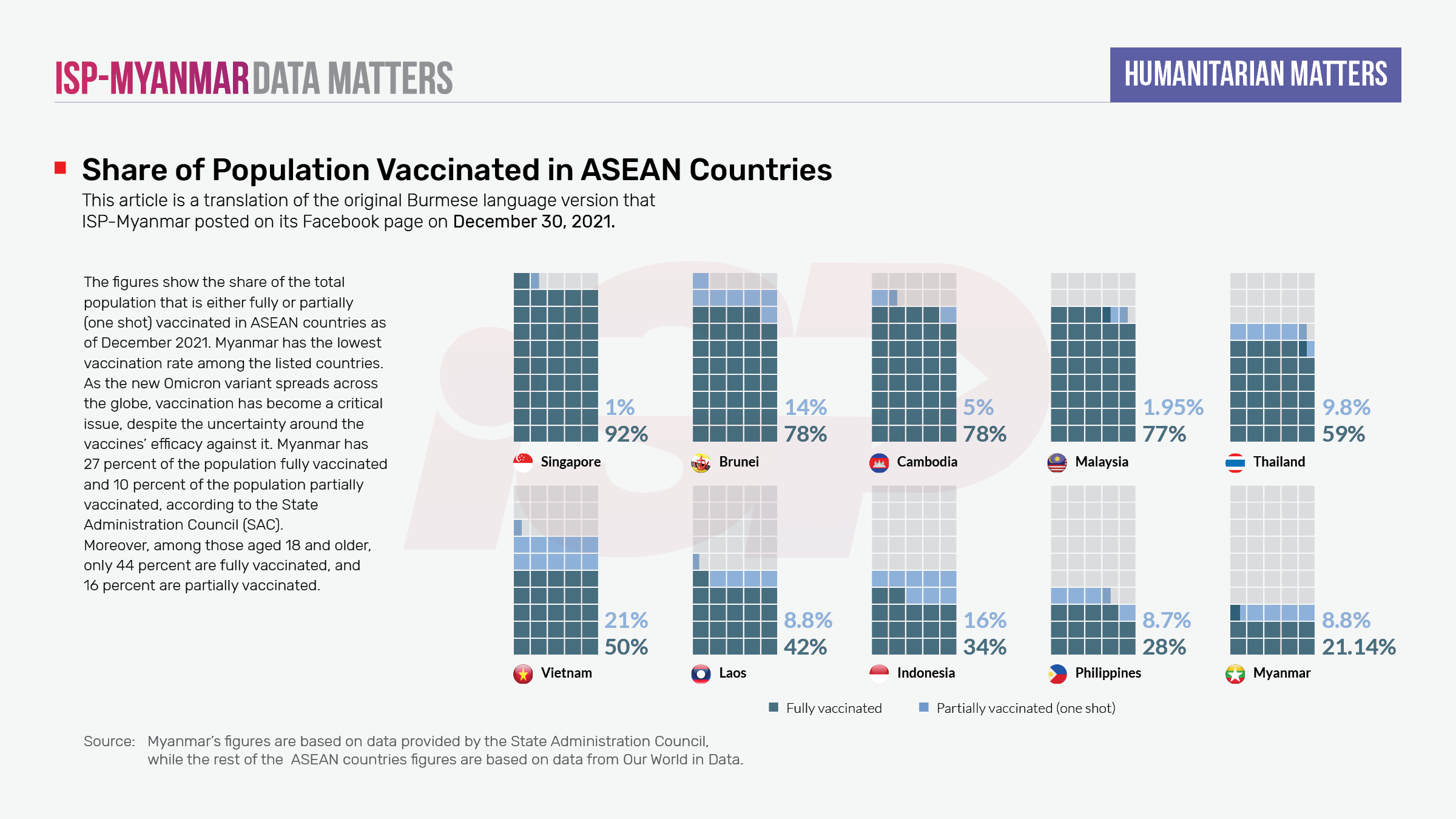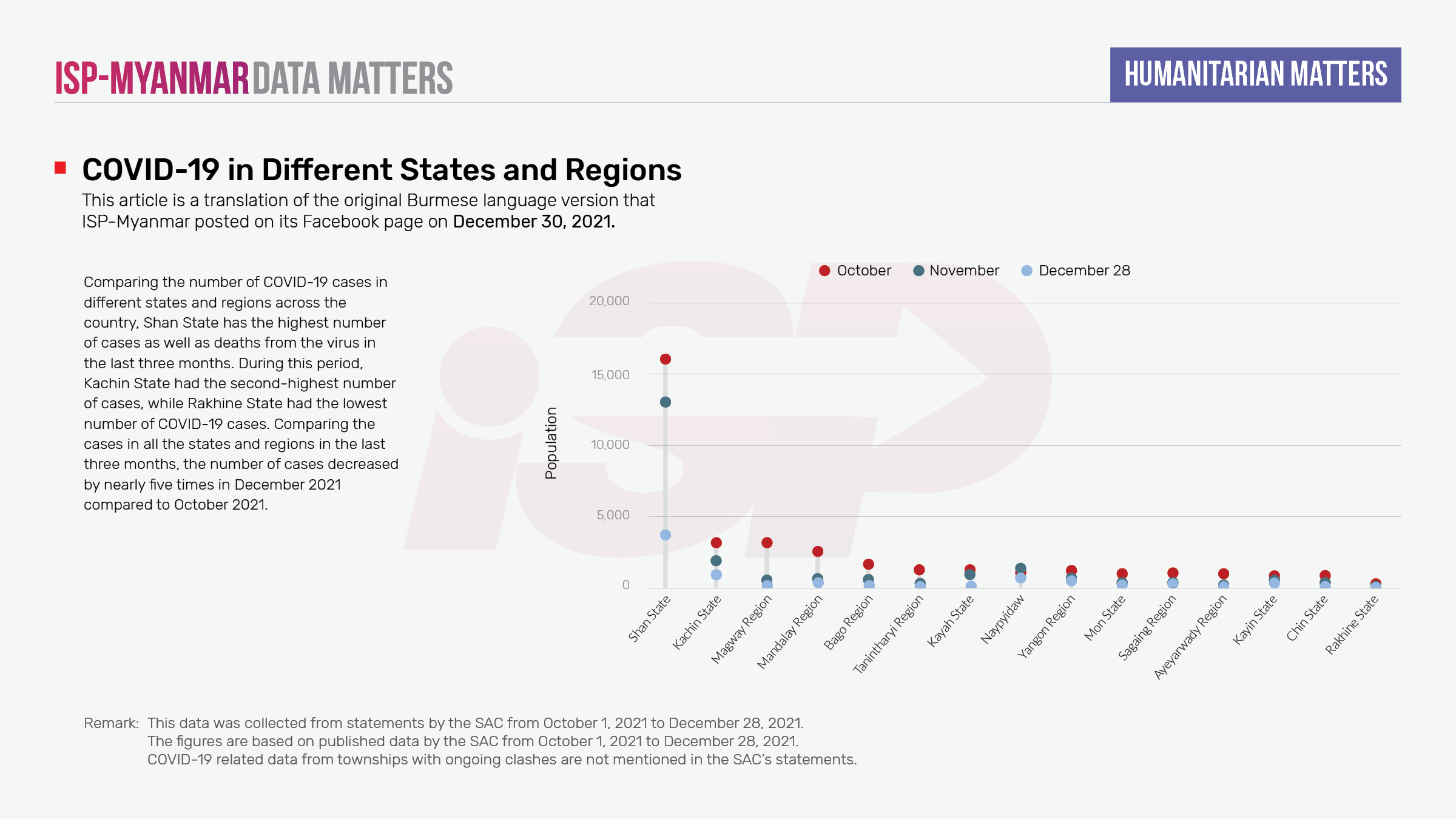
What Matters No. 75
(This article is a translation of the Burmese language version that ISP-Myanmar posted on its Facebook page on December 30, 2021.)
Four new cases with the new Omicron strain of COVID-19 have been found in Myanmar among recent international arrivals. The military council announced on December 28 that the infected individuals have been allowed to return home after the required quarantine period due to good health. Although there have yet to be any local transmission cases for the Omicron variant, there are concerns that it would spread rapidly within Myanmar as it has done in at least 122 countries around the world.
Other countries in the region including Thailand, Malaysia, Indonesia and India have seen a sharp rise in Omicron cases from 15 to 203 times more in the past month. As the threat of Omicron looms in neighboring countries, Myanmar should not treat this development lightly. The country is bound to face major challenges with the incoming new wave from Omicron, as it did when it was hit hard by the third wave of COVID-19 in the aftermath of the military coup. (Refer to What Matters No. 63)
Vaccination is the key factor here, since there is some evidence that getting booster vaccines would increase immunity to the Omicron variant. In Myanmar, those who have received the two full doses of the vaccine make up only 27 percent of the country’s population, the lowest in ASEAN. Therefore, if Omicron local transmission increases in the country, the situation may be more severe than the situation during the third wave of COVID.
What Matters No. 63 can be read at the following link:
https://www.ispmyanmar.com/burmese/2021/12/01/wm-63/
∎ Three times more contagious
According to preliminary findings in South Africa, the Omicron variant is said to be three times more contagious than the Beta and Delta variants. The World Health Organisation (WHO) warned on December 29 that the risk of infection is extremely high worldwide due to the Omicron variant. Omicron Tracker, which monitors the new variant, showed that Omicron has spread to 122 countries and territories worldwide with more than 330,000 cases and 59 deaths. Infections have also increased by more than 11 percent worldwide in the past week.
∎ Can Omicron cause severe illness?
According to the WHO, the preliminary findings show that there are no significant symptoms compared to other strains. The Omicron variant was also found to have fewer hospitalizations compared to the Delta variant. However, the European Center for Disease Control and Prevention (ECDC) warned that as the rate of transmission increases, there is a greater risk of infection and the greater the number of severe cases as well.
According to a New York Times article, the symptoms of the Omicron variant are similar to those of the Delta variant. The symptoms may vary depending on the reactions to the vaccines as well. The noticeable factors are that there are less cases of the loss of smell and taste, and the symptoms are similar to those of a “severe flu” and flu-like symptoms such as headaches, coughing, body ache, and high fever. Some cases also experienced difficulty in breathing.
∎ Will vaccines work?
The ECDC’s findings show that the vaccines are significantly less effective against Omicron. Pfizer and BioNtech announced that only after the third dose will the vaccine provide considerable protection. Reuters reported that even a booster dose of Sinopharm has weak protection against the Omicron variant. Similarly, the Sinovac booster is reported to be not very effective as well. Covishield and Covaxin vaccines are believed to be effective but more findings are needed to confirm this. The very best thing is to protect yourself by wearing masks and washing your hands frequently.
∎ Why does it matter?
In Myanmar, only 44 percent of the population over the age of 18 has been vaccinated twice, and the public health system is not fully operational. Therefore, it is important to monitor the developments of Omicron transmission and infection for Myanmar to prevent the unexpected spread of the virus among the public and for everyone to follow all recommended safety precautions.
∎ Other relevant readings
Statistics on the COVID-19 pandemic, announcements and regional transmission data can be found on the WHO website and at the Ministry of Health website. Information on the pandemic and vaccinations is available on the Johns Hopkins University’s Coronavirus Resource Center website and Our World in Data website, as well as through the COVID-19 Tracker by the Reuters news agency.




